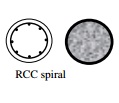Chapter: Civil : Design of Reinforced Concrete Elements : Limit State Design Of Columns
Behavior of Tied and Spiral Columns

Behavior of Tied and Spiral Columns
Figure
shows a portion of the core of a spiral column. Under a compressive load, the
concrete in this column shortens longitudinally under the stress and so, to
satisfy Poisson's ratio, it expands laterally. In a spiral column, the lateral
expansion of the concrete inside the spiral (referred to as the core) is
restrained by the spiral. This stresses the spiral in tension. For equilibrium,
the concrete is subjected to lateral compressive stresses. In a tied column in
a non seismic region, the ties are spaced roughly the width of the column apart
and, as a result, provide relatively little lateral restraint to the core.
Outward pressure on the sides of the ties due to lateral expansion of the core
merely bends them outward, developing an insignificant hoop-stress effect.
Hence, normal ties have little effect on the strength of the core in a tied
column. They do, however, act to reduce the unsupported length of the
longitudinal bars, thus reducing the danger of buckling of those bars as the
bar stress approaches yield. load-deflection diagrams for a tied column and a
spiral column subjected to axial loads is shown in figure. The initial parts of
these diagrams are similar. As the maximum load is reached, vertical cracks and
crushing develop in the concrete shell outside the ties or spiral, and this
concrete spalls off. When this occurs in a tied column, the capacity of the
core that remains is less than the load on the column. The concrete core is
crushed, and the reinforcement buckles outward between ties. This occurs
suddenly, without warning, in a brittle manner. When the shell spalls off a
spiral column, the column does not fail immediately because the strength of the
core has been enhanced by the triaxial stresses resulting from the effect of the
spiral reinforcement. As a result, the column can undergo large deformations,
eventually reaching a second maximum load, when the spirals yield and the
column finally collapses. Such a failure is much more ductile than that of a
tied column and gives warning of the impending failure, along with possible
load redistribution to other members. Due to this, spiral column carry little
more load than the tied column to an extent of about 5%. Spiral columns are
used when ductility is important or where high loads make it economical to
utilize the extra strength. Both columns are in the same building and have
undergone the same deformations. The tied column has failed completely, while
the spiral column, although badly damaged, is still supporting a load. The very
minimal ties were inadequate to confine the core concrete. Had the column ties
been detailed according to ACI Code, the column will perform better as shown.
Related Topics